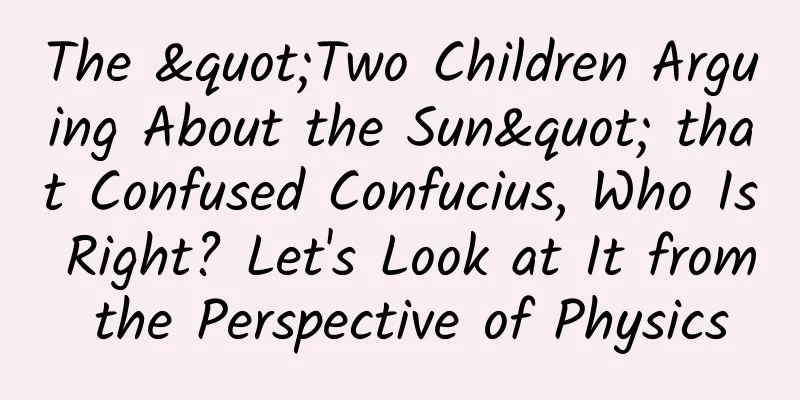The "Two Children Arguing About the Sun" that Confused Confucius, Who Is Right? Let's Look at It from the Perspective of Physics

|
"Two Children Arguing About the Sun" is an ancient Chinese article in the sixth grade Chinese textbook. The argument is about when the sun is farther away from us. How to explain this problem from a physical perspective? Let's see the analysis of these third grade students>>> Written by Wang Yingxuan, Zeng Yaqiao, and Chi Huchen (Beijing Chen Jinglun Middle School) Editor/Liu Zhao New Media Editor/Li Yunfeng "Two Children Arguing About the Sun" is an ancient Chinese text that we learned in the sixth grade Chinese textbook. It comes from "Liezi·Tangwen". The original text is as follows: Confucius traveled east and saw two children arguing and asked them why. One child said, "I think the sun is close to people when it first rises, but it is far away when it is at its zenith." The other child said, "I think the sun is far away when it first rises, but it is close when it is at its zenith." The other child said, "When the sun first rises, it is as big as a car cover, but when it is at its zenith, it is as small as a plate. Isn't it because the faraway one is small and the near one is big?" The other child said, "When the sun first rises, it is cold and blue, but when it is at its zenith, it is like dipping into hot water. Isn't it because the near one is hot and the far one is cold?" Confucius couldn't decide. The two children laughed and said, "Who of you knows more?" When I was in primary school, I was always curious about which of the two children was right? When exactly was the sun farther away from us? In order to solve this problem, we studied relevant physics knowledge in depth. Today, we will analyze the "Two Children Arguing About the Sun" from a scientific perspective. ▼ ▼ ▼ When does the sun move away from us? The distance between the sun and the earth refers to the distance from the sun's center to the earth's center. Due to the rotation and revolution of the earth, the distance between each position on the earth and the sun is changing at every moment. The main change is caused by the revolution of the earth. The orbit of the earth's revolution around the sun is an ellipse as shown in Figure 1, where the semi-major axis is 1.496×1011m, the semi-minor axis is 1.4958×1011m, the focal length is 5×109m, and its eccentricity is 0.0167. It takes about 365 days for the earth to revolve once, and it only takes about 6 hours from morning to noon, and the angle it rotates. Assuming that the earth is at point A in the morning as shown in Figure 1, then the earth is at point B at noon. It is known that the radius of the sun is r=6.955×108m, as shown in Figure 1, CC'=c+2r=6.391×109m. If CB=R, then C'B=2a-R. According to the law of cosines, we can get R=1.47094×1011m and CA=1.47100×108km. The change is 0.0001 billion kilometers, which is extremely small compared to the whole and can be ignored. So we think that the distance between the sun and us is constant within a day. Figure 1 ▼ ▼ ▼ Why do we feel hot at noon? According to the above analysis, we know that our distance from the sun is approximately the same in the morning and at noon, so distance is not the main factor affecting our perception of temperature. The temperature perceived by the human body is mainly the air temperature, that is, the air temperature. The heat in the air mainly comes from solar radiation (referring to the sun's energy transfer in the form of electromagnetic waves, and the electromagnetic waves and particle flows emitted by the sun into space). After the solar radiation reaches the ground, part of it is reflected and part is absorbed by the ground, causing the ground to heat up. The ground then transfers heat to the air through radiation, conduction and convection, which is the main source of heat in the air. There are three main factors that affect the ground temperature: heat accumulation, energy density and energy reduction. From the perspective of heat accumulation: at night, there is a bright moon in the sky, but no sun or radiation, so the earth does not receive any heat from the sun, resulting in a low temperature. In the morning, when the sky is just getting light, the solar radiation is small, and the ground does not accumulate a certain amount of heat. The temperature difference between the ground and the air is small, so almost no heat is transferred to the ground, resulting in a "cold and cool" morning. By noon, the ground has accumulated heat after nearly 6 hours of exposure to the sun, resulting in a large temperature difference between the ground and the air. The ground transfers heat to the air, the air temperature rises, and the temperature perceived by the human body also rises. Therefore, "noon is like touching hot water" is not "it's hot if you're close, but cool if you're far away." From the perspective of energy density: ground radiation is closely related to solar radiation. The energy of solar radiation is evenly distributed in all directions. As shown in Figure 2, in the morning, the sun shines obliquely on the earth. Because the earth is a sphere and its cross section is arc-shaped, the unit area of irradiation is larger; at noon, the sun shines directly on the ground, and the area of the ground it irradiates is smaller than in the morning. Because the energy contained in the solar radiation released by the sun to the earth is constant per unit time, the area of the ground irradiated at noon is small and the energy density is high, which will also make the ground temperature high at noon, the air temperature high, and the temperature perceived by the human body high. Figure 2 From the perspective of energy reduction: since the solar altitude angle is small in the morning and the atmospheric path it passes through is long, the atmosphere has a greater weakening effect on solar radiation, and the solar radiation reaching the ground will be weaker; but at noon, the solar altitude angle is large and the atmospheric path it passes through is short, the atmosphere has a smaller weakening effect on solar radiation, and the solar radiation reaching the ground is large, which is one of the reasons why the atmospheric temperature at noon is higher than in the morning. ▼ ▼ ▼ Why does the sun appear bigger in the morning? The distance between the sun and the earth is almost the same in the morning and at noon, so why do we see the sun as bigger in the morning? Is it our eyes deceiving us? Through the study of junior high school physics, we know that the lens of the human eye can be regarded as a convex lens. When light of different wavelengths passes through the lens of the human eye at the same time, the light with a short wavelength has a short focal length and falls in front of the retina; the light with a long wavelength has a long focal length and falls behind the retina. Therefore, there is a certain difference in the clarity of the image on the retina. The focal length of the long-wavelength warm-color image is inaccurate, and the image formed on the retina is blurred and has a certain diffusion; the short-wavelength cold-color image is clearer and has a certain sense of contraction. This is why we usually feel dizzy when staring at red. If we change to cyan, there will be no such phenomenon. Therefore, when different colors of light are emitted from the same position, warm-colored light will make people feel closer, while cold-colored light will often make people feel farther away. The sun in the morning is red, and the sun at noon is white, so people feel that the sun in the morning is farther and the sun at noon is closer. There are many other types of visual errors, as shown in Figure 3. These visual errors affect people's judgment of distance and size. As shown in Figure 3(a), people tend to think that the central white block is larger than the black block. As shown in Figure 3(b), people tend to think that the gray line in the middle is slanted. This is the sense of expansion and contraction of color. Figure 3(a) Figure 3(b) When the retina forms an image, different parts of the human eye lens have different refractive powers for the incident light, so that the light can no longer converge at one point after refraction, thus producing aberrations, which causes the boundary of the contour of the image with strong contrast to have a contrast-enhanced boundary effect. The contour of the image of the object with higher brightness on the retina is like a circle of light surrounding it, which makes the image of the object on the retina larger and looks a little bigger than the real object, that is, the "light leakage phenomenon" (a white shape against a black or dark background has a strong reflected light and leaks out in an expansion manner). When the sun rises in the morning, it is surrounded by a dark sky. The sun will appear brighter due to the contrast of the human eye, making people feel very large; at noon, the sky is similar in color to the sun, and the contrast between the sun and the sky is not large, so it appears smaller. In addition, the contrast of shapes is also one of the reasons why we observe that the size of the sun is different in the morning and at noon. The same object will appear small when placed in a group of objects that are larger than it, and will appear large when placed in a group of objects that are smaller than it. For example, a watermelon placed near a box of cherries will appear large; but when the watermelon is placed together with a whole jackfruit fruit, the watermelon will appear small. In the same way, the sun at sunrise is surrounded by trees or houses, so the sun will appear large in comparison; at noon, the sun is in the sky, and in comparison, it will appear smaller. This leads to people's perception of the size of the sun as being larger in the morning and smaller at noon. The argument between the two children stems from their one-sided perspectives on the issue. As science and technology develop, we are getting closer and closer to the essence of things through constant exploration and thinking. The development and improvement of science is always accompanied by criticism and reflection. Whether it is out of curiosity about natural phenomena or out of responsibility for promoting the progress of human history, the spirit of independent thinking and bold questioning of the two children in ancient China deserves to be passed on forever. |||| Produced by: Science Central Kitchen Produced by: Beijing Science and Technology News | Beijing Science and Technology Media Welcome to share to your circle of friends Reproduction without authorization is prohibited |
<<: Carcinogenic? Loss of nutrients? Air fryers are in trouble...
>>: Monkeypox virus has spread to many countries. Why is it so scary?
Recommend
AC vs. DC, who will win?
More than 100 years ago, Tesla's alternating ...
Volkswagen executives may have known about the amount of compensation for cheating and were suspected of failing to inform investors in a timely manner
According to German newspaper Bild am Sonntag, Vo...
Caocao talks about movies: a comprehensive course on movie commentary
"Cao Cao Talks about Movies: A One-stop Guid...
One article tells the past and present of the "short video trend"
On April 22, Papi Jiang, who became famous throug...
Why do high-end Internet giants fall in love with low-end wall painting?
Jingdong wall painting Taobao wall painting As a ...
State determines view - thinking about front-end development based on state
In today's front-end community, concepts such...
The video industry has experienced many twists and turns. Where will it go in 2015?
In 2014, the three giants BAT continued to recrui...
Douyin overseas version was reported for illegal use of OBS and other source codes
In mid-December, TikTok, the overseas version of ...
How to increase the number of followers by 30,000 in one month without any hot spots?
The Double Eleven shopping carnival has passed, a...
Highlights of GMIC's first day: The big guys are absent and robots become the highlight
Although various industry conferences have become...
Deep Blue S7 launches new 520Pro pure electric version, a more worthwhile pure electric SUV, priced at 179,900 yuan
According to the official news of Deep Blue Auto,...
After reading this scientific sun protection guide, you will have a beautiful summer!
This summer, the scorching sun and high temperatu...
10 strategic indicators on how to quickly increase the volume of advertising!
This article will introduce in detail the specifi...
Is it possible to know everyone in the world? Is this theory really so amazing?
Audit expert: Chen Mingxin National Level 2 Psych...









